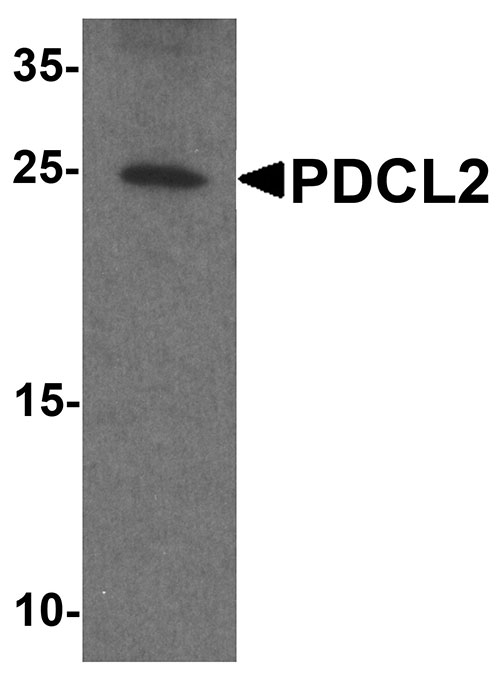PDCL2 Antibody
- SPECIFICATION
- CITATIONS
- PROTOCOLS
- BACKGROUND

Application
| WB, E |
|---|---|
| Primary Accession | Q8N4E4 |
| Other Accession | NP_689614, 51944950 |
| Reactivity | Human, Mouse, Rat |
| Host | Rabbit |
| Clonality | Polyclonal |
| Isotype | IgG |
| Calculated MW | Predicted: 27 kDa Observed: 25 kDa |
| Application Notes | PDCL2 antibody can be used for detection of PDCL2 by Western blot at 1 - 2 µg/ml. |
| Gene ID | 132954 |
|---|---|
| Target/Specificity | PDCL2; PDCL2 antibody is human, mouse and rat reactive. PDCL2 antibody is predicted to not cross-react with other members of the PDCL protein family. |
| Reconstitution & Storage | PDCL2 antibody can be stored at 4℃ for three months and -20℃, stable for up to one year. |
| Precautions | PDCL2 Antibody is for research use only and not for use in diagnostic or therapeutic procedures. |
| Name | PDCL2 |
|---|---|
| Function | Essential for male fertility, spermiogenesis and acrosome formation. |
| Cellular Location | Endoplasmic reticulum {ECO:0000250|UniProtKB:Q78Y63} |
| Tissue Location | Testis-specific. |

Thousands of laboratories across the world have published research that depended on the performance of antibodies from Abcepta to advance their research. Check out links to articles that cite our products in major peer-reviewed journals, organized by research category.
info@abcepta.com, and receive a free "I Love Antibodies" mug.
Provided below are standard protocols that you may find useful for product applications.
Background
Phosducin-like proteins (PhLPs) are a conserved family of proteins with thioredoxin-like domains that were initially identified as modulators of G protein signaling (1,2). PDCL2 is highly homologous to PDCL and shares an N-terminal helix domain and a C-terminal thioredoxin-fold (Trx-fold) domain (3). PDCL2 has been shown to interact with the chaperonin CCT and is essential for cytoskeletal protein function and cell cycle progression (4).
References
Miles MF, Barhite S, Sganga M, et al. Phosducin-like protein: an ethanol-responsive potential modulator of guanine nucleotide-binding protein function. Proc. Natl. Acad. Sci. USA 1993; 90:10831-5.
Ruiz-Gomez A, Humrich J, Murga C, et al. Phosphorylation of phosducin and phosducinlike protein by G protein-coupled receptor kinase 2. J. Biol. Chem. 2000; 275:29724-30.
Lou X, Bao R, Zhou CZ, et al. Structure of the thioredoxin-fold domain of human phosducin-like protein 2. Acta Crystallographica 2009; F65:67-70.
Stirling PC, Srayko M, Takhar KS, et al. Functional interaction between phosducin-like protein 2 and cytosolic chaperonin is essential for cytoskeltal protein function and cell cycle progrssion. Mol. Biol. Cell 2007; 18:2336-45.
If you have used an Abcepta product and would like to share how it has performed, please click on the "Submit Review" button and provide the requested information. Our staff will examine and post your review and contact you if needed.
If you have any additional inquiries please email technical services at tech@abcepta.com.













 Foundational characteristics of cancer include proliferation, angiogenesis, migration, evasion of apoptosis, and cellular immortality. Find key markers for these cellular processes and antibodies to detect them.
Foundational characteristics of cancer include proliferation, angiogenesis, migration, evasion of apoptosis, and cellular immortality. Find key markers for these cellular processes and antibodies to detect them. The SUMOplot™ Analysis Program predicts and scores sumoylation sites in your protein. SUMOylation is a post-translational modification involved in various cellular processes, such as nuclear-cytosolic transport, transcriptional regulation, apoptosis, protein stability, response to stress, and progression through the cell cycle.
The SUMOplot™ Analysis Program predicts and scores sumoylation sites in your protein. SUMOylation is a post-translational modification involved in various cellular processes, such as nuclear-cytosolic transport, transcriptional regulation, apoptosis, protein stability, response to stress, and progression through the cell cycle. The Autophagy Receptor Motif Plotter predicts and scores autophagy receptor binding sites in your protein. Identifying proteins connected to this pathway is critical to understanding the role of autophagy in physiological as well as pathological processes such as development, differentiation, neurodegenerative diseases, stress, infection, and cancer.
The Autophagy Receptor Motif Plotter predicts and scores autophagy receptor binding sites in your protein. Identifying proteins connected to this pathway is critical to understanding the role of autophagy in physiological as well as pathological processes such as development, differentiation, neurodegenerative diseases, stress, infection, and cancer.


